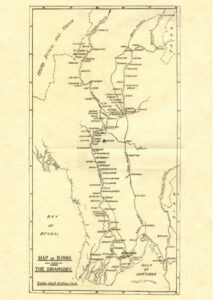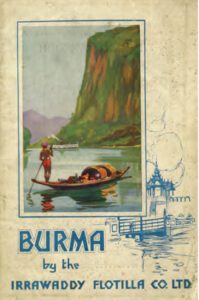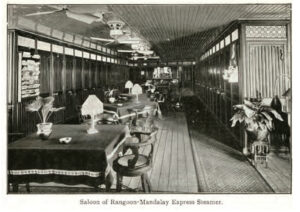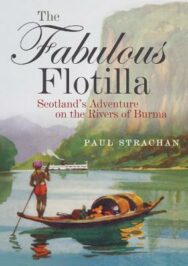‘To say that Burma is a land of rivers is an understatement.’
Paul Strachan has written a history of the rivers of Burma and the paddle steamers run by Scottish companies in the 19th and early 20th centuries. Below is an extract and some photos from this book which is illustrated throughout.
The Fabulous Flotilla: Scotland’s Adventure on the Rivers of Burma
By Paul Strachan
Published by Whittles Publishing
Standing anywhere along the bank of the Irrawaddy, or Ayeyarwady, river, you will see an average of at least 500,000 cubic feet of water flowing past you every second. In the monsoon it it would be just over 2,000,000 cubic feet per second. Such a flow represents one of the greatest challenges to navigation, and as the channels and sands shift daily the river cannot be charted. It is buoyed – haphazardly – only in the low water season. Officially the river begins at a confluence of streams from the Himalayas near Myitkyina in Kachin state, from where it flows 1,370 miles into the Indian Ocean. It is navigable by larger vessels for just over 1,000 miles. Its main tributary is the Chindwin, which runs for 750 miles, of which 600 are navigable by lighter vessels.
These are not of course the only rivers in Burma. The Irrawaddy has several other tributaries, which extend into a vast area, and altogether the Irrawaddy basin covers over 150,000 square miles. Then there is the Salween which, at 1,749 miles, is the longest river in Burma, though navigable for only its lowest 50 miles or so, such is the strength of its flow. From the south-eastern port of Moulmein1 there is a whole network of rivers, mainly navigable for some distance, and in the western coastal region of the Arakan there is a river system of dazzling complexity, the main form of communication in a land with few roads. Finally, the several thousand square miles of the Irrawaddy Delta have an uncounted number of creeks and channels. To say that Burma is a land of rivers is an understatement.
In the distant past peoples migrated from deep inland down these river valleys; first came the Pyu, the proto-Burmans, ethnically Tibeto-Burmese, then the Mien, or Myan, the Burmans themselves. They lived in city-states that were like oases in jungles full of wild animals. Upriver came trade from India, bringing Indian religious cults, Hindu and Buddhist – the latter in a mix of what was later to be defined as Mahayana and Theravada, but until the ‘purification’ by the 11th-century kings of Pagan2 these two divisions would have been seen as one and the same.
All movement – of goods, cultures, religions, armies – in this country was by river, and this remained so till the late 20th century. Back in the 12th century the King of Ceylon mounted a naval raid and, having crossed the Indian Ocean, sailed upriver to seize valued elephants to take back home. In the 13th century the Mongols under Genghis Khan were to sail down the river and take Pagan. There followed several centuries of Mon–Burmese3 conflict in which armies were shipped up and down the Irrawaddy in great barges. Then the British arrived, and in three short, sharp river wars annexed the country in stages. Thereafter the British colonisation and economic development (or exploitation, depending on your viewpoint) all took place along the rivers, assisted by the development of the Irrawaddy Flotilla, which after 1864 became a Scottish concern.

Map of Burma and the Irwaddy River.

Handbook: a guide book for tourists produced by the IFC in 1935. Burma’s most famous artist, U Ba Nyan, was commissioned to illustrate the cover.

The saloon of a typical express steamer, with the tiny cabins off to the sides. The saloon would be ventilated by air blowing through from a forward opening when the ship was in motion. Note also the electric fans.
The Fabulous Flotilla: Scotland’s Adventure on the Rivers of Burma by Paul Strachan is published by Whittles Publishing, priced £18.99.
ALSO IN THIS ISSUE

 Shadows and Light: The Extraordinary Life of James McBey
Shadows and Light: The Extraordinary Life of James McBey
‘ McBey – an international Scot par excellence who lived in London, the US and Morocco – largely shu …














